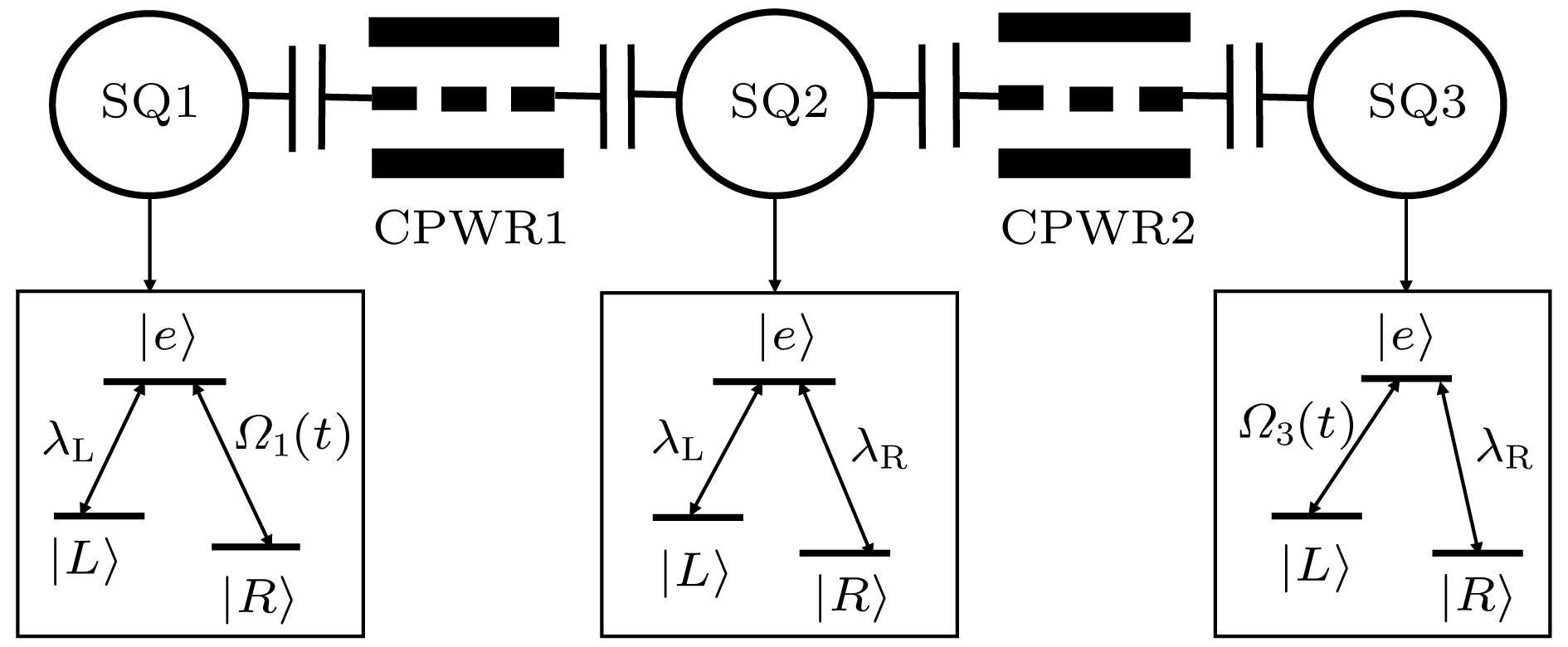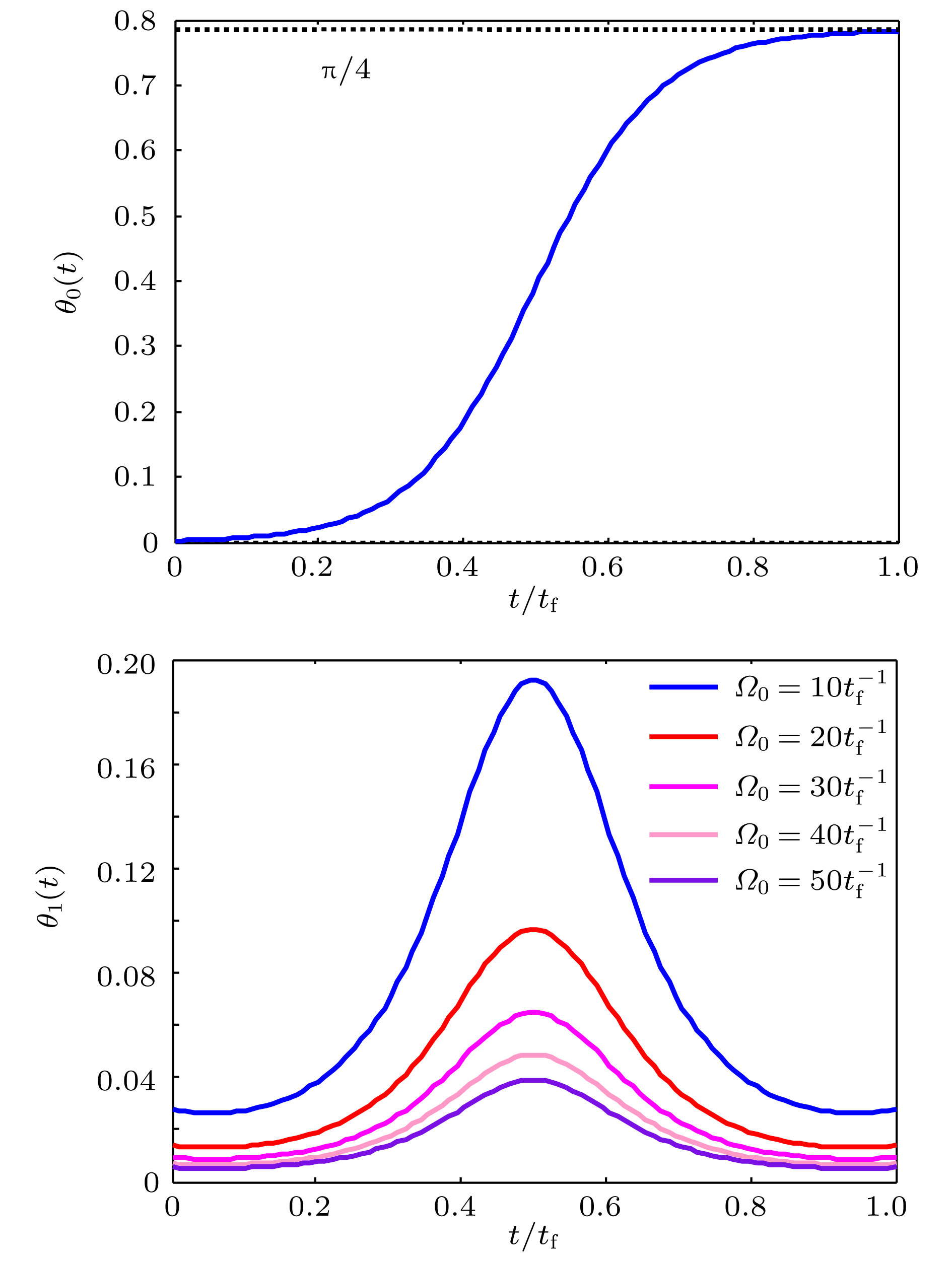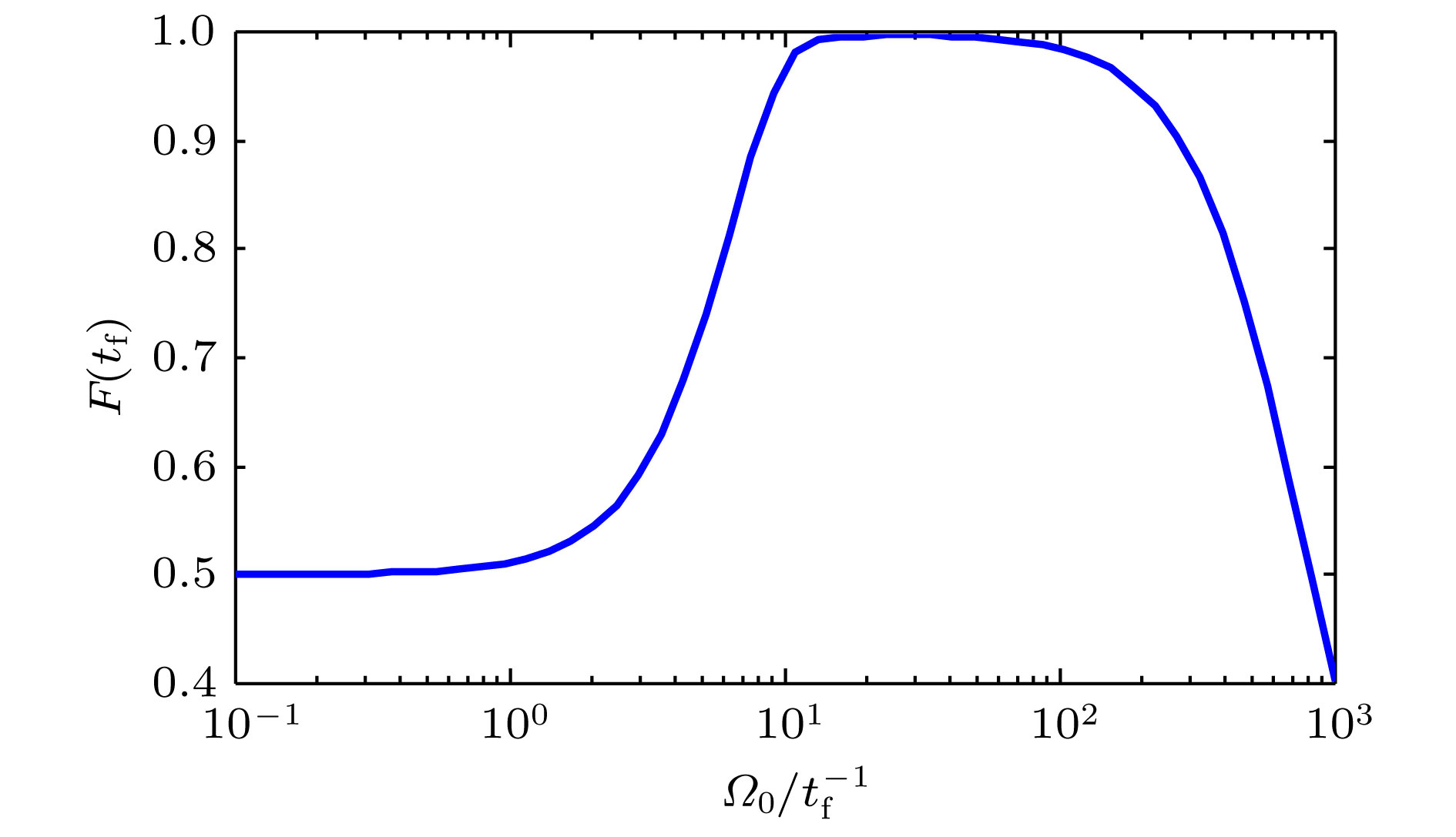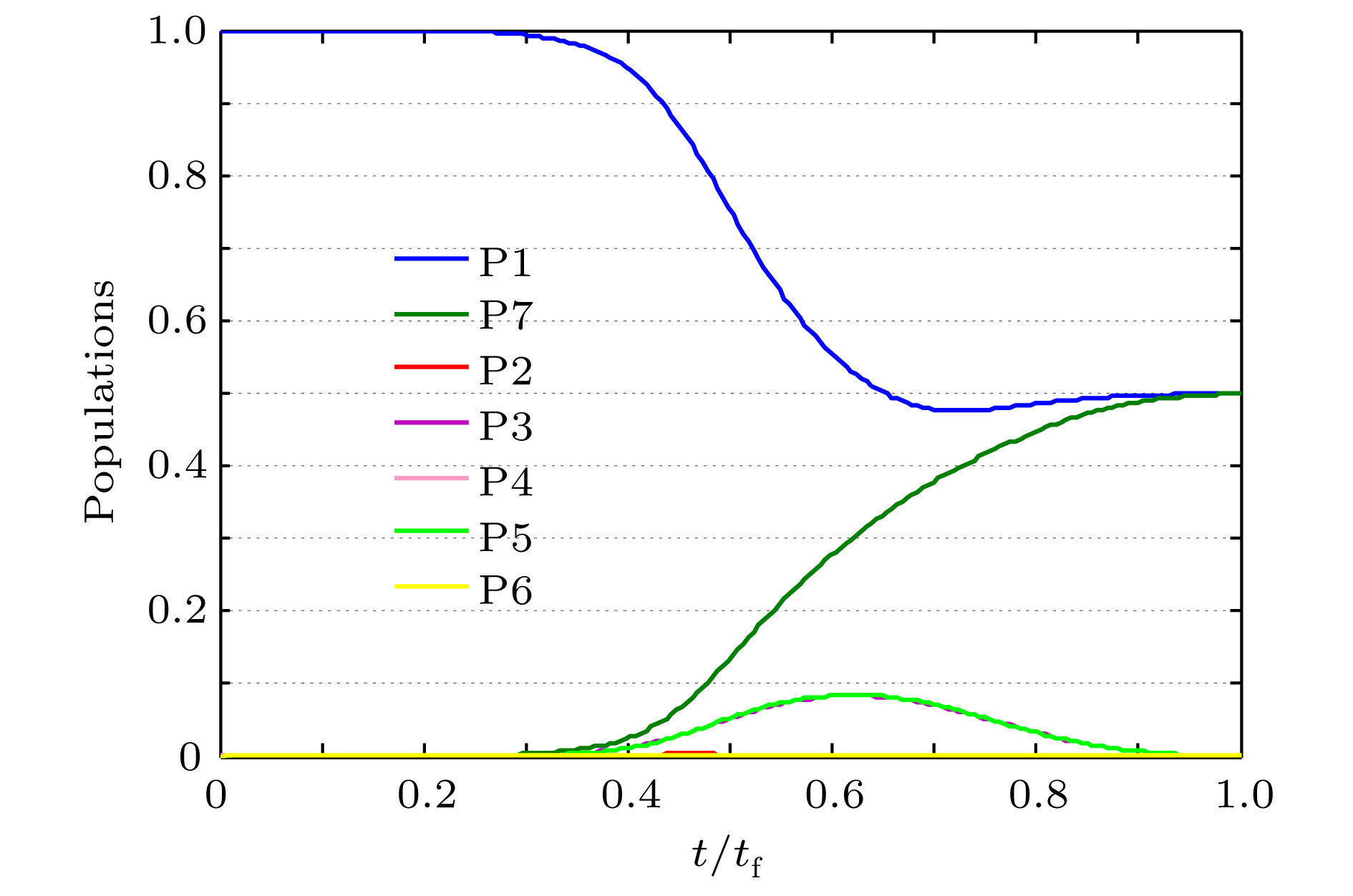-
本文提出了一个基于超绝热捷径技术快速制备超导三量子比特Greenberger-Horne-Zeilinger态的理论方案. 该方案首先在量子Zeno动力学的帮助下得到系统的有效哈密顿量, 之后通过引入与有效哈密顿量具有相同形式的反向导热哈密顿量来构建绝热捷径, 加速了整个系统的演化过程. 该方案不需要初态和目标态之间的直接耦合, 在实验上也更容易实现. 数值模拟结果表明该方案对超导量子比特的自发辐射、波导谐振腔的泄漏以及超导量子比特的退相位是鲁棒的.
-
关键词:
- 超绝热捷径 /
- 超导量子比特 /
- Greenberger-Horne-Zeilinger态
With the development of quantum information processing (QIP), entangled states have been used in many important fields. One of the well-known entangled states is Greenberger-Horne-Zeilinger (GHZ) state, which provides a possibility for testing quantum mechanics against local hidden theory without using Bell’s inequality. Many schemes of generating the GHZ state have been put forward in various physical systems over the past ten years. Among these physical systems, the superconducting qubits (SQs) have the potential suitability for the integrated devices in QIP and can be controlled easily through modulating electromagnetic signals and designing level configurations. On the other hand, adiabatic passage is a typical method which is used widely to generate entanglements. However, adiabatic passage needs long evolution time to satisfy the adiabatic condition. Therefore, to speed up a slow quantum adiabatic process, a new kind of technique called " shortcuts to adiabatic passage (STAP)” has attracted much attention. The Lewis-Riesenfeld invariants and transitionless quantum driving are famous methods of STAP. But they are difficult to use in the experiment. For the Lewis-Riesenfeld invariants, the driving pulses are not smoothly turned on or off and thus lead to severe impediments in experiment. For transitionless quantum driving, a direct coupling between the initial state and the target state is needed, but is too hard to obtain experimentally. In this paper, we propose a theoretical scheme for fast generating GHZ state of three superconducting qubits via superadiabatic-based shortcuts. Firstly, with the help of quantum Zeno dynamics, we obtain the effective Hamiltonian of the system, then we choose a suitable counterdiabatic Hamiltonian in the same form as the effective Hamiltonian and add it to the effective Hamiltonian in order to construct shortcuts to adiabatic passage, which can make the system evolve along one of the superadiabatic states and thus accelerate the evolution process of the system. More importantly, the superadiabatic scheme does not need an additional coupling between the initial and finial state, which ensures its high experimental feasibility. In addition, numerical simulation results show that the proposed scheme is robust against spontaneous emission, the cavity photon leakage and the dephasing of SQs.-
Keywords:
- superadiabatic-based shortcuts /
- superconducting qubit /
- Greenberger-Horne-Zeilinger state
[1] Li X H, Deng F G, Zhou H Y 2006 Phys. Rev. A 74 054302
 Google Scholar
Google Scholar
[2] Karlsson A, Bourennane M 1998 Phys. Rev. A 58 4394
 Google Scholar
Google Scholar
[3] Xiao L, Long G L, Deng F G, Pan J W 2004 Phys. Rev. A 69 052307
 Google Scholar
Google Scholar
[4] Zeilinger A, Horne M A, Weinfurter H 1997 Phys. Rev. Lett. 78 3031
 Google Scholar
Google Scholar
[5] Zheng S B 2001 Phys. Rev. Lett. 87 230404
 Google Scholar
Google Scholar
[6] Leibfriend D, Knill E, Seidelin S 2005 Nature 438 639
 Google Scholar
Google Scholar
[7] Su X L, Tan A, Jia X J 2007 Phys. Rev. Lett. 98 070502
 Google Scholar
Google Scholar
[8] Raimond J M, Brune M, Haroche S 2001 Rev. Mod. Phys. 73 565
 Google Scholar
Google Scholar
[9] Kang Y H, Chen Y H, Wu Q C 2016 Sci. Rep. 6 36737
 Google Scholar
Google Scholar
[10] Clarke J, Wilhelm F K 2008 Nature 453 1031
 Google Scholar
Google Scholar
[11] Shinkai G, Hayashi T, Ota T, Fujisawa T 2009 Phys. Rev. Lett. 103 056802
 Google Scholar
Google Scholar
[12] Makhlin Y, Shnirman A 2001 Rev. Mod. Phys. 73 357
 Google Scholar
Google Scholar
[13] Wu J L, Song C, Xu J 2016 Quantum Inf. Process 15 3663
 Google Scholar
Google Scholar
[14] Zhang X, Chen Y H, Wu Q C 2017 Laser Phys. 27 015202
 Google Scholar
Google Scholar
[15] Xu J, Yu L, Wu J L, Ji X 2017 Chin. Phys. B 26 090301
 Google Scholar
Google Scholar
[16] Berry M V 1987 Proc. R. Soc. Lond. A 414 31
 Google Scholar
Google Scholar
[17] Facchi P, Marmo G, Pascazio S 2009 J. Phys.: Conf. Ser. 196 012017
 Google Scholar
Google Scholar
[18] Shen L T, Wu H Z, Chen R X 2011 J. Phys. B 44 205503
 Google Scholar
Google Scholar
[19] Yang R C, Li G, Zhang T C 2013 Quantum. Inf. Process 12 493
 Google Scholar
Google Scholar
[20] Demirplak M, Rice S A 2008 J. Phys. Chem. A 129 154111
 Google Scholar
Google Scholar
[21] Demirplak M, Rice S A 2008 J. Chem. Phys. 116 8028
 Google Scholar
Google Scholar
-
图 5 (a)
$\gamma $ 和$\kappa $ 对目标态保真度的影响; (b)${\gamma _\phi }$ 和$\gamma $ 对目标态保真度的影响; (c)$\kappa $ 和${\gamma _\phi }$ 对目标态保真度的影响Fig. 5. (a) Denpendence on
$\gamma $ and$\kappa $ of fidelity; (b) denpendence on$\gamma $ and${\gamma _\phi }$ of fidelity; (c) dependence on$\kappa $ and${\gamma _\phi }$ of fidelity. -
[1] Li X H, Deng F G, Zhou H Y 2006 Phys. Rev. A 74 054302
 Google Scholar
Google Scholar
[2] Karlsson A, Bourennane M 1998 Phys. Rev. A 58 4394
 Google Scholar
Google Scholar
[3] Xiao L, Long G L, Deng F G, Pan J W 2004 Phys. Rev. A 69 052307
 Google Scholar
Google Scholar
[4] Zeilinger A, Horne M A, Weinfurter H 1997 Phys. Rev. Lett. 78 3031
 Google Scholar
Google Scholar
[5] Zheng S B 2001 Phys. Rev. Lett. 87 230404
 Google Scholar
Google Scholar
[6] Leibfriend D, Knill E, Seidelin S 2005 Nature 438 639
 Google Scholar
Google Scholar
[7] Su X L, Tan A, Jia X J 2007 Phys. Rev. Lett. 98 070502
 Google Scholar
Google Scholar
[8] Raimond J M, Brune M, Haroche S 2001 Rev. Mod. Phys. 73 565
 Google Scholar
Google Scholar
[9] Kang Y H, Chen Y H, Wu Q C 2016 Sci. Rep. 6 36737
 Google Scholar
Google Scholar
[10] Clarke J, Wilhelm F K 2008 Nature 453 1031
 Google Scholar
Google Scholar
[11] Shinkai G, Hayashi T, Ota T, Fujisawa T 2009 Phys. Rev. Lett. 103 056802
 Google Scholar
Google Scholar
[12] Makhlin Y, Shnirman A 2001 Rev. Mod. Phys. 73 357
 Google Scholar
Google Scholar
[13] Wu J L, Song C, Xu J 2016 Quantum Inf. Process 15 3663
 Google Scholar
Google Scholar
[14] Zhang X, Chen Y H, Wu Q C 2017 Laser Phys. 27 015202
 Google Scholar
Google Scholar
[15] Xu J, Yu L, Wu J L, Ji X 2017 Chin. Phys. B 26 090301
 Google Scholar
Google Scholar
[16] Berry M V 1987 Proc. R. Soc. Lond. A 414 31
 Google Scholar
Google Scholar
[17] Facchi P, Marmo G, Pascazio S 2009 J. Phys.: Conf. Ser. 196 012017
 Google Scholar
Google Scholar
[18] Shen L T, Wu H Z, Chen R X 2011 J. Phys. B 44 205503
 Google Scholar
Google Scholar
[19] Yang R C, Li G, Zhang T C 2013 Quantum. Inf. Process 12 493
 Google Scholar
Google Scholar
[20] Demirplak M, Rice S A 2008 J. Phys. Chem. A 129 154111
 Google Scholar
Google Scholar
[21] Demirplak M, Rice S A 2008 J. Chem. Phys. 116 8028
 Google Scholar
Google Scholar
计量
- 文章访问数: 11419
- PDF下载量: 89
- 被引次数: 0














 下载:
下载:






























